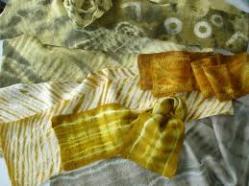Kashmiri Shawls have been renowed since centuries and were the pride of French Queen, Marie Antoinette. With a long tradition of artistic excellence, the shawl is one of the most admired handmade fabric of Kashmir. Superb in workmanship, the unmatched magnificence is brought out by hand embroidery.
It is said that the shawls from Kashmir were famous even in the times of emperor Ashok (3rd C BC) but many writers credited Sultan Zain-Ul-Abidin (1420-1470 A.D) as the initiator of Shawl industry in Kashmir. It may be the Sultan whose enlightened rule encouraged promotion of arts as an organized trade and the Pashmina or in Persian called “Pashm” that we know today is a legacy of that period.
Shawls are worn and used as a warm protective garment all over the northern states today. Kashmir has become synonymous with shawls all over the world. It is a work of delicacy, tremendous concentration and too much of patience. The decoration is formed by weft threads interlocked where the colors change, the weavers passing them between the warps using bobbins around, which the variously colored threads are wound. The raw material for pashmina is brought from and taken to for hand-weaving followed by embroidery and finishing.
Kashmiri shawls are rare and unique, due to its peculiar charm that is derived from the symphony of color schemes depicting architectural and mythological figures interwoven with landscape designs. There are three fibres from which Kashmiri shawls are made – wool, pashmina and shahtoosh. The prices of the three cannot be compared – woollen shawls being within reach of the most modest budget, and shahtoosh being a one-in-a-lifetime purchase.
Woollen shawls are popular because of the embroidery worked on them, which is unique to Kashmir. Both embroidery and the type of wool used bring about differences in the price. Wool woven in Kashmir is known as raffle .
Cashmere shawls and Pashmina Shawls have a delicate, silky softness that sets them apart from ordinary woolen shawls. Obtained from the fleecy undergrowth of the rare Kashmiri goat through traditional combing techniques, their delicate silky softness carries an aura of luxury & class that made it the choice of kings and nobility in a bygone era. We design, fabricate and export an exquisite range of Cashmere Shawls embellished with ethnic Kashimiri work and other elegant designs.
Although pure pashmnina is expensive, the cost is sometimes brought down by blending it with rabbit fur or with wool. It is on pashmina shawls that Kashmir’s most exquisite embroidery is executed, sometimes covering the entire surface, earning it the name of ‘jamawar’. A Jamawar shawl can, by virtue of the embroidery, increase the value of a shawl threefold.
Shahtoosh, from which the legendary ‘ring shawl’ is made, is incredibly light, soft and warm. The astronomical price it commands in the market is due to the scarcity of the raw material. High in the plateaux of Tibet and the eastern part of Ladakh, at an altitude of above 5,000 m, roam the Tibetan antelope (Pantholops Hodgsoni). During grazing, a few strands of the downy hair from the throat are shed which are painstakingly collected by the nomads, eventually to supply to the Kashmiri shawl makers as shahtoosh.

An example of Sozni shawl
Many kinds of embroidery is worked on shawls. ‘Sozni’ (needlework) is generally done in a panel along the sides of the shawl. Sozni is often done so skilfully that the motif appears on both sides of the shawl, each side having a different colour scheme. This naturally has a bearing on the cost.
Another type of needle embroidery is popularly known as ‘papièr mâchè’ work because of the design and the style in which it is executed. This is done either in broad panels on either side along the breadth of a shawl, or covering the entire surface of the breadth of a shawl or that of a stole.

Famous Aari work of Kashmir
A third type of embroidery is Aari or hook embroidery. Motifs here are the well-known flower design finely worked in concentric rings of chain stitch.
A less frequently seen weave done only on pashmina, covers the surface with tiny lozenge shaped squares, earning it the delightful name of ‘chashm-e-bulbul,’ or “eye of the bulbul”. As this weave is a masterpiece of the weaver’s art, it is normally not embroidered upon.
Kashmir shawls were first worn in fashionable circles in the West in the third quarter of the eighteenth century, and by 1800 the shawl trade between Kashmir and the West was well established. The appearance of European agents in Kashmir added fresh colour to an already cosmopolitan scene.
Besides woven imitations Persia also produced embroidered shawls in the Kashmir style but the fact remains that KASHMIRI Shawls have become a must have for every women because of its Royal appeal.





